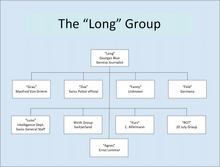Georges Blun
Georges Blun | |
|---|---|
Alsace-Lorraine, German Empire | |
| Died | 1999 |
| Nationality | French |
| Citizenship | French |
| Occupation(s) | Journalist, Spy |
| Espionage activity | |
| Allegiance |
|
| Service branch | Red Three |
| Codename | Long |
| Operations | Red Orchestra |
Georges Blun (1 June 1893 – 1999)[1] was a French journalist and intelligence agent who was the Berlin correspondent of the Journal de Paris.[2][3]
Early life, World War I and the interwar years
Georges Blun was born to a French family on 1 June 1893 in the then German-held region of
From 1925 to 1930 he worked in the Weimar Republic as a correspondent for various newspapers, such as Journal des débats.[4]
In 1928, it was reported that following publication of a controversial ('distorted') article on the Silvesternacht (New Year's Eve) in Berlin in a Paris paper, he resigned his chairmanship of the Association of Foreign Press and made an apology visit to the government press department.[citation needed]
He returned to Switzerland in 1939 after having worked as a journalist in Berlin for a considerable amount of time.[6]
World War II

During
During the war, he spied primarily and most notably in service of the
During his clandestine activities, he worked with figures such as Hans Bernd Gisevius, members of the 20 July plot, as well as Joseph Wirth (who had served as Chancellor of Germany).[7][9][4]
Blun's group was viewed by the Soviets as the second most valuable, after the group led by Rachel Dübendorfer.[7]
Post-War life
Blun survived the war, following which, along with Otto John and several others, he reportedly became a member of a political group led by Josef Müller. The group advocated for a united and neutralist Germany with a pro-USSR alignment.[7]
He was still working as a journalist on 11 May 1950, when he penned an article in the French Le Monde newspaper regarding the division of Berlin[10] and was cited for his work covering the division of the country.[11]
He died in 1999.[1]
Publications
- L'Allemagne mise a nu (La nouvelle Soc. d'Edition, Paris,. 1927, 183 p.) The Observer described it as being about "the German attitude toward foreign politics."[12] Foreign Affairs stated it was, "Germany as seen by the Berlin correspondent of the Paris Journal."[2]
References
- ^ a b "ISNI 0000000358781199 Blun, Georges (born 1893-06-01 deceased 1999)". www.isni.org. Retrieved 14 February 2020.
- ^ a b Langer, William L. "Some Recent Books on International Relations." Foreign Affairs, vol. 7, no. 1, 1928, pp. 156–167. JSTOR, www.jstor.org/stable/20028674. Accessed 10 February 2020.
- ^ ISBN 9780810858220. Retrieved 10 February 2020.
- ^ ISBN 978-5-6993-1250-4. Retrieved 14 February 2020 – via www.e-reading.life.
- ISBN 978-5-7654-4469-6.
- ^ ISBN 978-0-8108-6421-4– via books.google.com.
- ^ a b c d e Tittenhofer, Mark A. "The Rote Drei: Getting Behind the 'Lucy' Myth". CIA Library. Center for the Study of Intelligence. Archived from the original on 31 July 2019. Retrieved 22 February 2019.
- ISBN 9780241189917; Section: "The Red Orchestra“ … George Blun Group.
- ISBN 0-89093-203-4.
- ^ Blun, Georges (11 May 1950). "Les alliés n'envisagent pas de discuter LA RÉPONSE SOVIÉTIQUE sur les élections quadriparties à Berlin" [The Allies do not plan to discuss SOVIET RESPONSE to four-party elections in Berlin]. Le Monde.fr (in French). Retrieved 14 February 2020.
- . Retrieved 23 December 2023.
- ^ "Books and Authors". The Observer. 20 May 1928.
